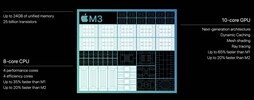Apple A18 Pro vs Apple M3
Apple A18 Pro
► remove from comparison
The Apple A18 Pro is a powerful smartphone processor and formal successor to the A17 Pro. This new member of the Apple A processor series debuted in September 2024 alongside the iPhone 16 Pro and iPhone 16 Pro Max; it features 2 performance cores and 4 efficient cores along with a 35 TOPS NPU and the 6-core A18 Pro GPU.
The chip is said to be in large part based on the v9.2A ARM microarchitecture for near-Apple M4 IPC. 5G, Wi-Fi 7, Bluetooth 5.3, various satellite navigation systems and NFC are all supported here.
The more affordable A18 SoC has the same 2 P-cores and 4 E-cores running at slightly lower clock speeds along with a significantly slower graphics adapter. The Pro version of the chip also boasts USB 3.x support whereas devices powered by the A18 are limited to USB 2.0 speeds.
Performance
Its multi-thread benchmark scores leave the Dimensity 9300 as well as the Apple A17 Pro and the Apple A18 pretty far behind with at least a 10% advantage. Overall, Apple M1-like performance is to be expected in short-term workloads.
In the meantime, its single-thread performance comes dangerously close to the M3 and M4 chips despite their higher clocks speeds and slightly more advanced architectures. (The A18 Pro's performance cores can run at just slightly over 4.0 GHz, as far as we know.)
Performance drops are inevitable when under longer-term stress since there is no active cooling solution of any kind here.
Graphics
Like any modern graphics adapter, the 6-core A18 Pro GPU is RT-enabled. It delivers benchmark scores that are most comparable to the Immortalis-G720 MP12, Adreno 740 and Adreno 750; as a matter of fact, it even manages to beat the 7-core M1 GPU in many tests which is rather impressive. Any 2024 and 2025 iOS game will be happy with such an iGPU.
Power consumption
It appears the chip is able to briefly consume up to about 10 W when under high load, with average sustained power consumption figures hovering around 4 W.
The pretty modern TSMC N3E manufacturing process makes the A-series chip very power-efficient, as of late 2024.
Apple M3
► remove from comparison
The Apple M3 is a system on a chip (SoC) from Apple for notebooks that was introduced in late 2023. It integrates a new 8-core CPU with 4 performance cores with up to 4.06 GHz and 4 efficiency cores running at up to 2.75 GHz. Apple claims that the CPU is up to 20% faster than in the old Apple M2 (3.5 GHz).
Due to the higher clock speeds and architecture improvements, the processor performance is also significantly better than the M2 in benchmarks (see e.g. Geekbench below) and can keep up with the fastest CPUs in short single-core tests (like the Raptor Lake i9-13950HX).
The M3 also integrates a new graphics adapter with dynamic caching, mesh shading and ray tracing acceleration called Apple M3 10-Core GPU. According to Apple, it is 20% faster than the GPU in the M2. The chip integrates again 10 GPU cores, but the cheaper variant only offers 8 cores (e.g. in the entry iMac). Later in early 2025 Apple also introduced a 9-core variant in the new iPad Air models. Furthermore, the GPU only supports 2 displays (an additional 6K60 display to the internal one).
Both GPU and CPU can access the unified memory on the package together. It is still available in 8, 16 and 24 GB variants and offers the same 100 GB/s maximum bandwidth (unlike the Pro models that feature a reduced memory bandwidth).
The integrated 16-core Neural Engine has also been revised and now offers 18 TOPS peak performance (versus 15.8 TOPS in the M2 but 35 TOPS in the new A17 Pro). The video engine now supports AV1 decoding in hardware. H.264, HEVC and ProRes (RAW) can still be decoded and encoded.
Unfortunately, the integrated wireless network module only supports Wi-Fi 6E (no Wi-Fi 7) and due to the support of only a single external monitor, the chip also has to make do with no Thunderbolt 4 (Thunderbolt 3 / USB 4 support only for up to 40 Gbit/s).
The chip is manufactured on the current 3nm TSMC process (N3B most likely) and contains 25 billion transistors (+25% vs. Apple M2). The 3nm process should also contribute to the excellent efficiency of the chip. Under load, the M3 CPU consumes approximately 20 Watt.
| Model | Apple A18 Pro | Apple M3 | ||||||||||||||||||||||||||||||||||||||||||||
| Series | Apple Apple A-Series | Apple M3 | ||||||||||||||||||||||||||||||||||||||||||||
| Series: M3 |
|
| ||||||||||||||||||||||||||||||||||||||||||||
| Clock | <=4000 MHz | 2748 - 4056 MHz | ||||||||||||||||||||||||||||||||||||||||||||
| Cores / Threads | 6 / 6 2 x 4.0 GHz Apple A18 P-Core 4 x 2.2 GHz Apple A18 E-Core | 8 / 8 4 x 4.1 GHz Apple M3 P-Core 4 x 2.7 GHz Apple M3 E-Core | ||||||||||||||||||||||||||||||||||||||||||||
| TDP Turbo PL2 | 10 Watt | |||||||||||||||||||||||||||||||||||||||||||||
| Technology | 3 nm | 3 nm | ||||||||||||||||||||||||||||||||||||||||||||
| Features | 16-core Neural Engine, USB 3.2 Gen 2 (10 Gbps) | ARMv8 Instruction Set | ||||||||||||||||||||||||||||||||||||||||||||
| Architecture | ARM | ARM | ||||||||||||||||||||||||||||||||||||||||||||
| Announced | ||||||||||||||||||||||||||||||||||||||||||||||
| L2 Cache | 4 MB | |||||||||||||||||||||||||||||||||||||||||||||
| Transistors | 25000 Million | |||||||||||||||||||||||||||||||||||||||||||||
| iGPU | Apple M3 10-Core GPU | |||||||||||||||||||||||||||||||||||||||||||||
| Manufacturer | www.apple.com |
Benchmarks
Average Benchmarks Apple A18 Pro → 100% n=11
Average Benchmarks Apple M3 → 114% n=11
* Smaller numbers mean a higher performance
1 This benchmark is not used for the average calculation












